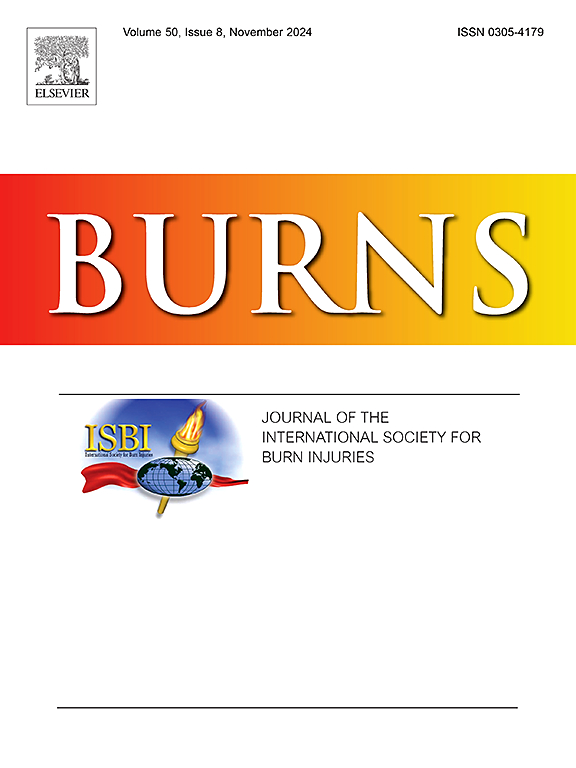通过生物信息学分析和实验验证确定 PANoptosis 相关基因在烧伤中的潜在作用
IF 3.2
3区 医学
Q2 CRITICAL CARE MEDICINE
引用次数: 0
摘要
本文章由计算机程序翻译,如有差异,请以英文原文为准。
Identification of the potential role of PANoptosis-related genes in burns via bioinformatic analyses and experimental validation
Background
The treatment of burns is highly challenging due to their complex pathophysiological mechanisms. PANoptosis, as an important form of cell death, is suggested to play a crucial role in the inflammatory response and tissue damage following burns. However, the role of PANoptosis-related biomarkers in the pathophysiological processes of burns remains unclear. In this study, we aim to identify PANoptosis-related signature genes and validate them as biomarkers in burns
Methods
Burn-related datasets were obtained from the Gene Expression Omnibus(GEO) database. GSE37069 was used for bioinformatic analysis and machine learning, while GSE19743 was used specifically for external validation. A set of PANoptosis-associated genes was obtained from the GeneCards database. Three machine learning models (LASSO, RF, and SVM-RFE) and WGCNA were utilized to screen for signature genes. The diagnostic efficacy of the identified genes was assessed through receiver operating characteristic (ROC) curves. Gene Set Enrichment Analysis (GSEA) was performed to identify pathways associated with the signature genes, while single-sample gene set enrichment analysis (ssGSEA) was employed to investigate the immune landscape. Finally, Western blotting and RT-qPCR were employed to validate the signature genes.
Results
BCL-2, CCAR1, CERK, TRIAP1, S100A8, and SNHG1 were identified as signature genes. The biological processes involving these genes mainly include endocytosis, apoptosis, and ECM receptor interaction. Immune infiltration analysis revealed that neutrophils, eosinophils, M0 macrophages, and monocytes are significantly elevated in burn samples. Additionally, these signature genes showed significant correlations with multiple immune cell types. Finally, Western blotting and RT-qPCR analysis revealed that the expression levels of BCL2, CCAR1, CERK, and TRIAP1 were significantly down-regulated in the burn groups compared to the normal groups, with the exception of S100A8.
Conclusion
Our study has identified BCL-2, CCAR1, CERK, and TRIAP1 as reliable potential biomarkers for burn injuries. These genes play crucial roles in immune response, wound healing, and anti-apoptotic mechanisms, which are key pathological processes involved in the progression of burn injuries. Specifically, BCL-2, CCAR1, CERK, and TRIAP1 have been shown to significantly impact the regulation of inflammation, the efficiency of wound repair, and the prevention of cell apoptosis during burn injury.
求助全文
通过发布文献求助,成功后即可免费获取论文全文。
去求助
来源期刊

Burns
医学-皮肤病学
CiteScore
4.50
自引率
18.50%
发文量
304
审稿时长
72 days
期刊介绍:
Burns aims to foster the exchange of information among all engaged in preventing and treating the effects of burns. The journal focuses on clinical, scientific and social aspects of these injuries and covers the prevention of the injury, the epidemiology of such injuries and all aspects of treatment including development of new techniques and technologies and verification of existing ones. Regular features include clinical and scientific papers, state of the art reviews and descriptions of burn-care in practice.
Topics covered by Burns include: the effects of smoke on man and animals, their tissues and cells; the responses to and treatment of patients and animals with chemical injuries to the skin; the biological and clinical effects of cold injuries; surgical techniques which are, or may be relevant to the treatment of burned patients during the acute or reconstructive phase following injury; well controlled laboratory studies of the effectiveness of anti-microbial agents on infection and new materials on scarring and healing; inflammatory responses to injury, effectiveness of related agents and other compounds used to modify the physiological and cellular responses to the injury; experimental studies of burns and the outcome of burn wound healing; regenerative medicine concerning the skin.
 求助内容:
求助内容: 应助结果提醒方式:
应助结果提醒方式:


